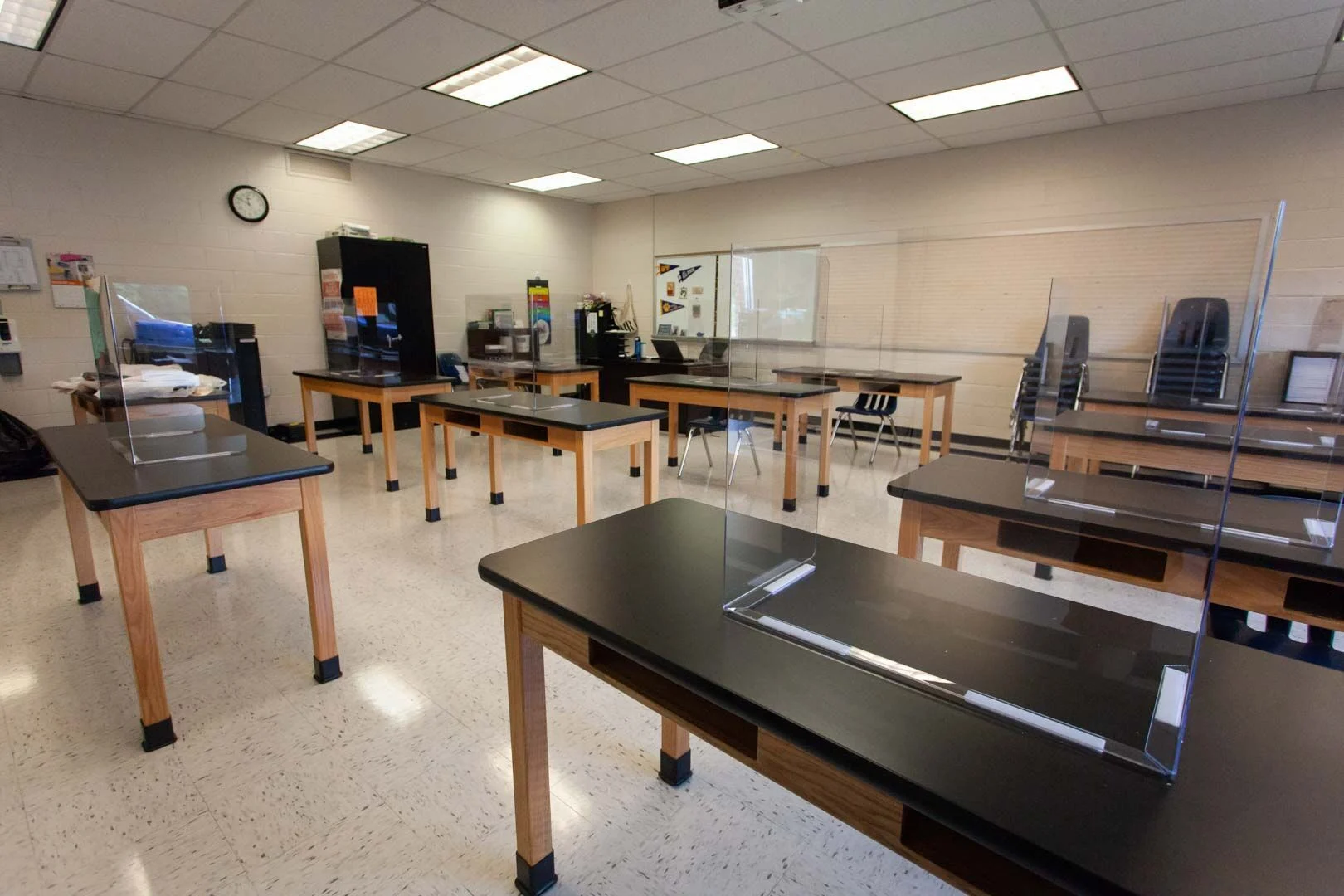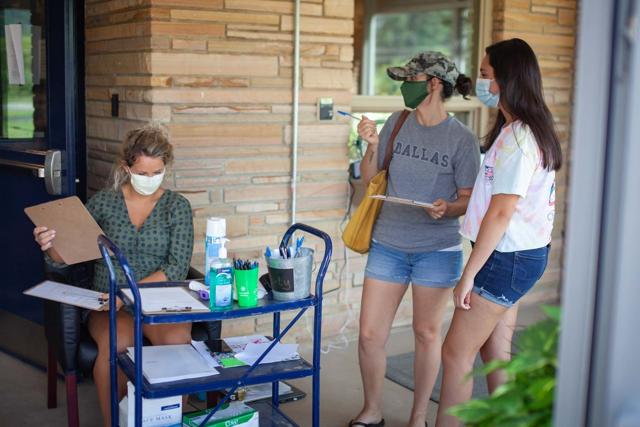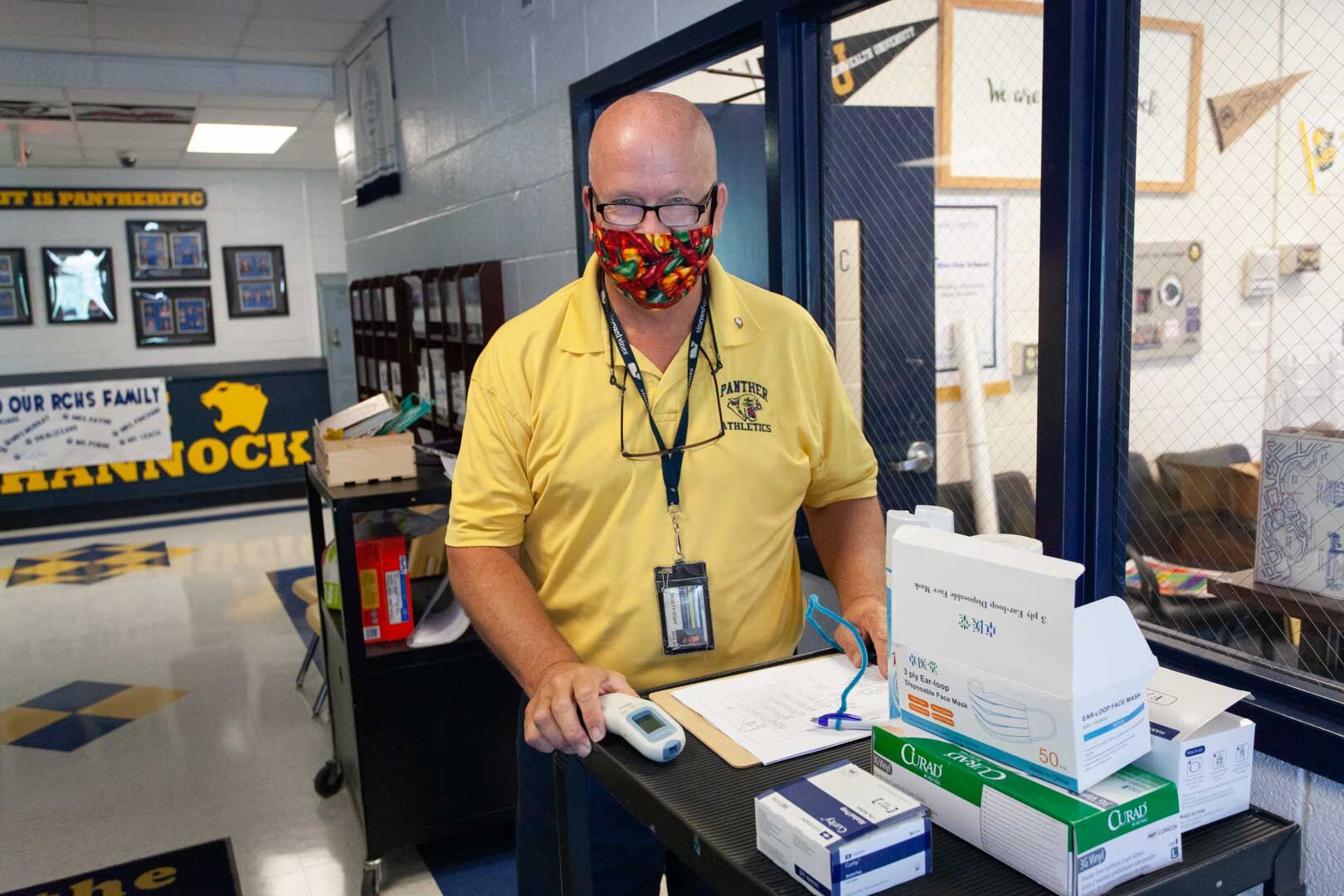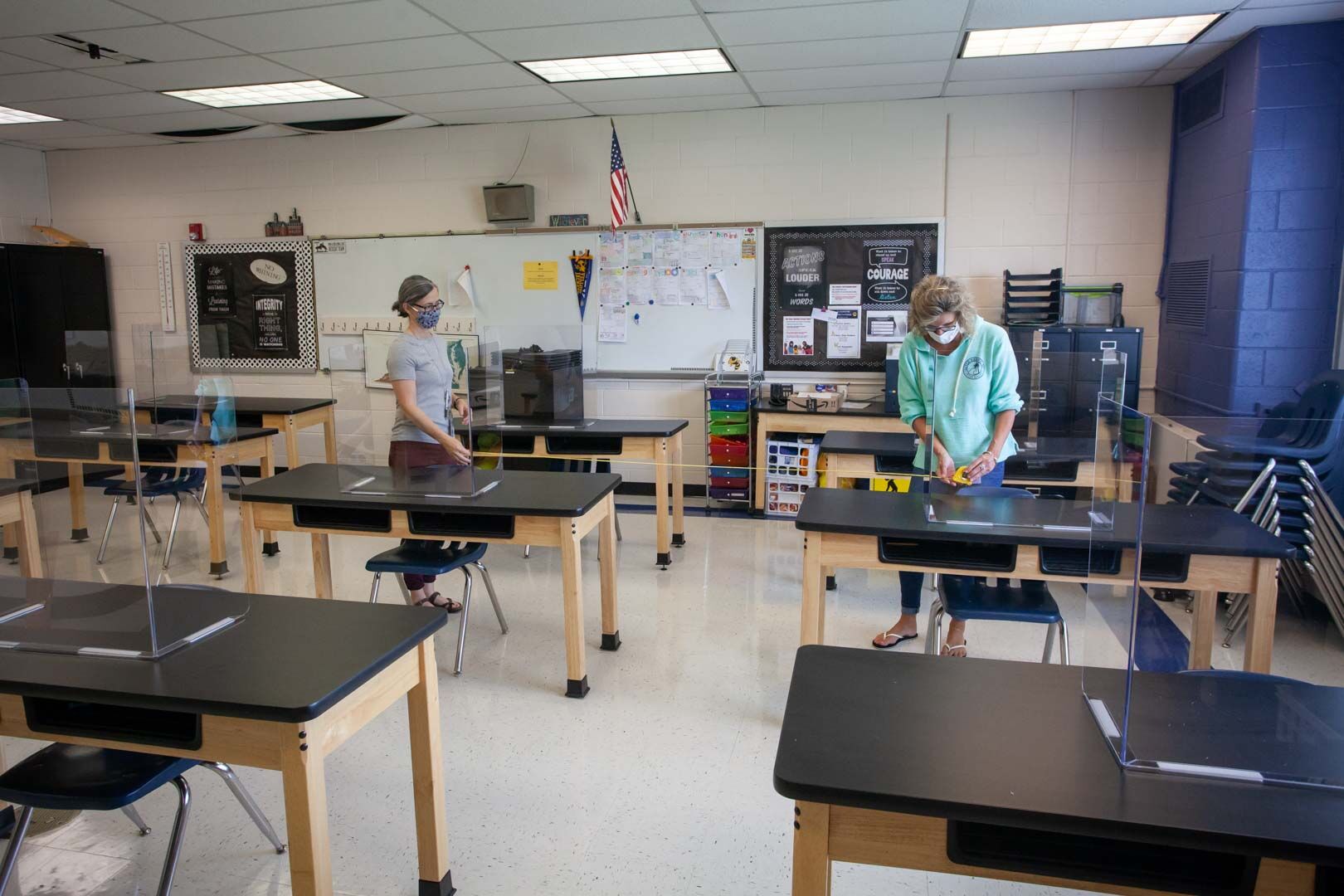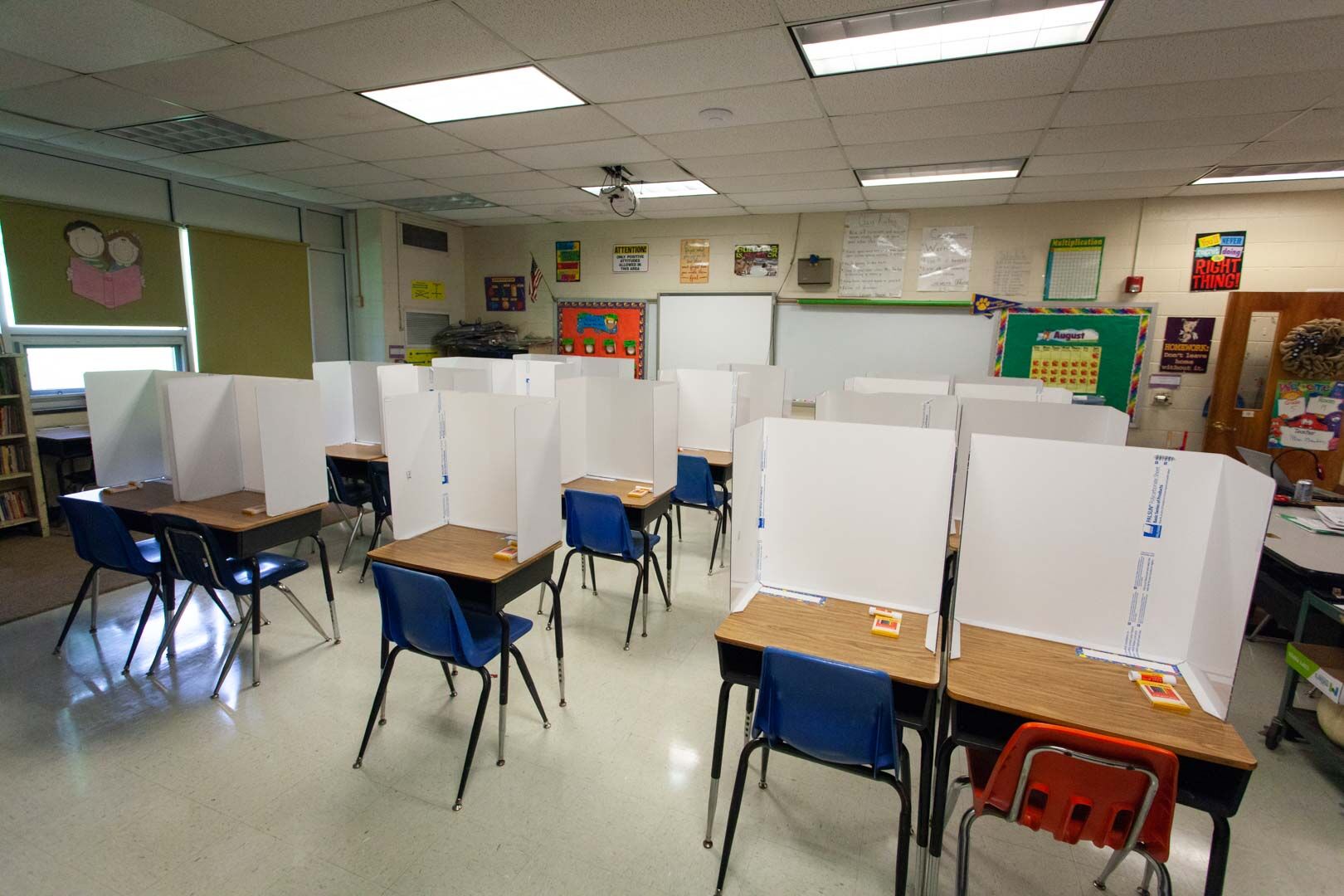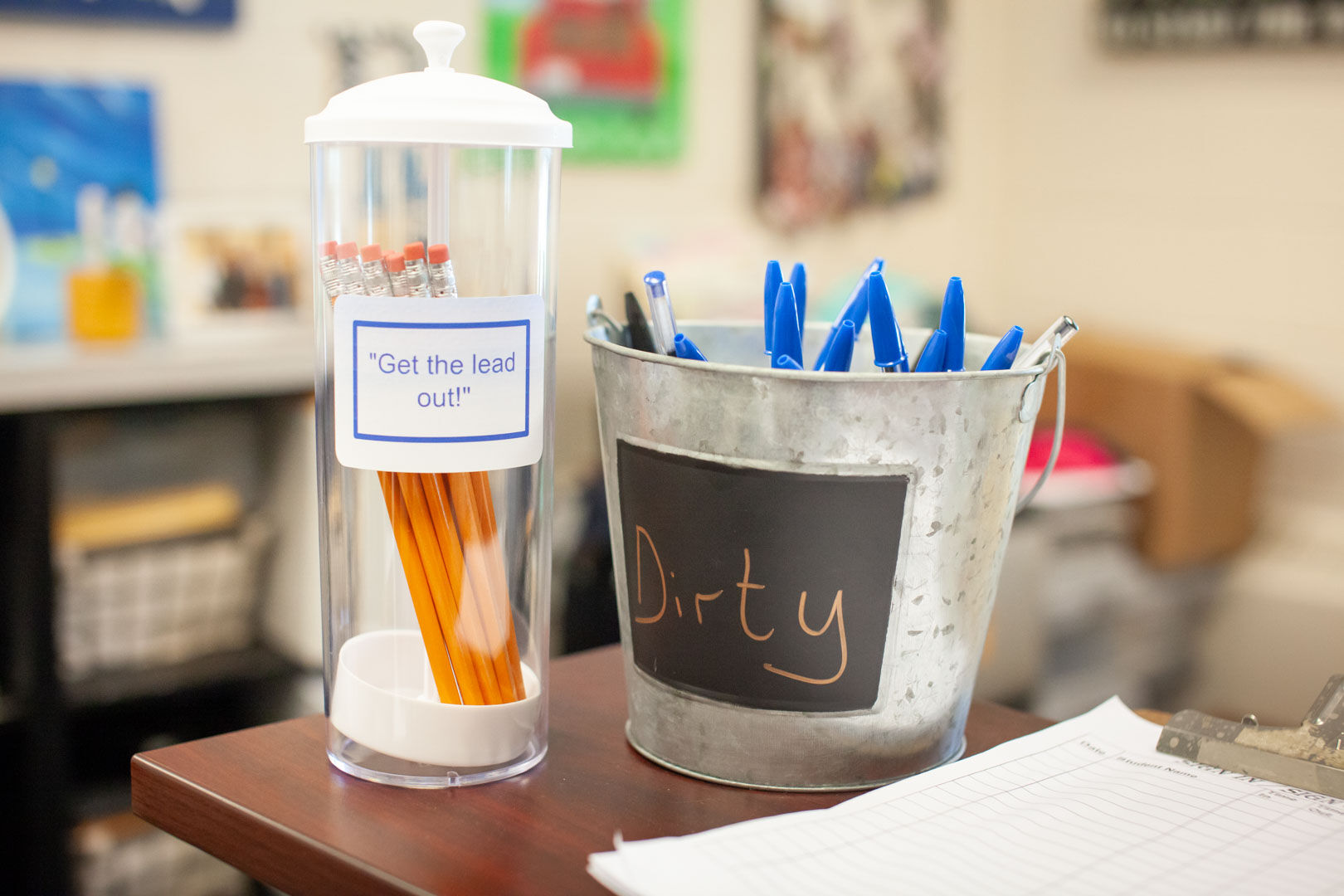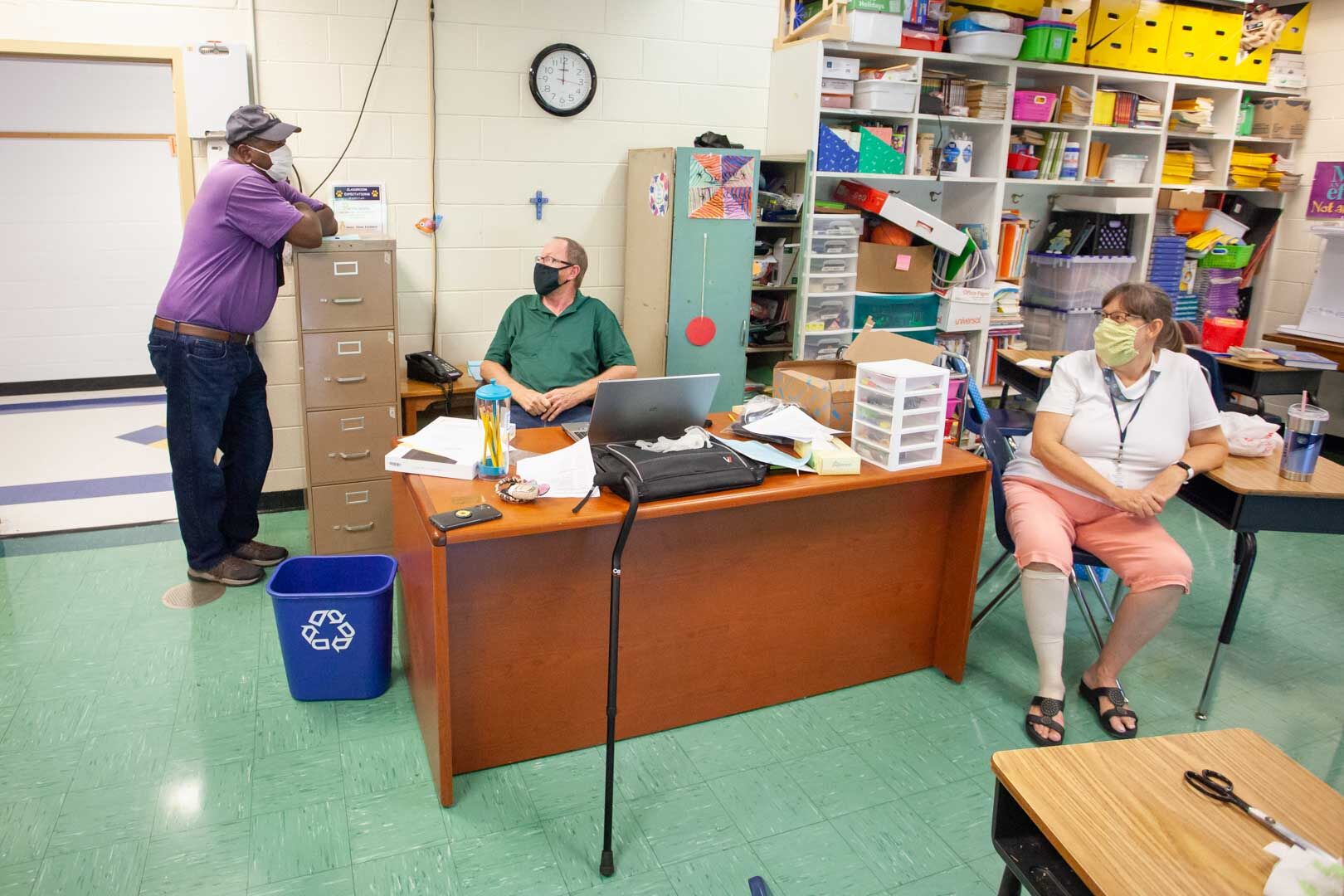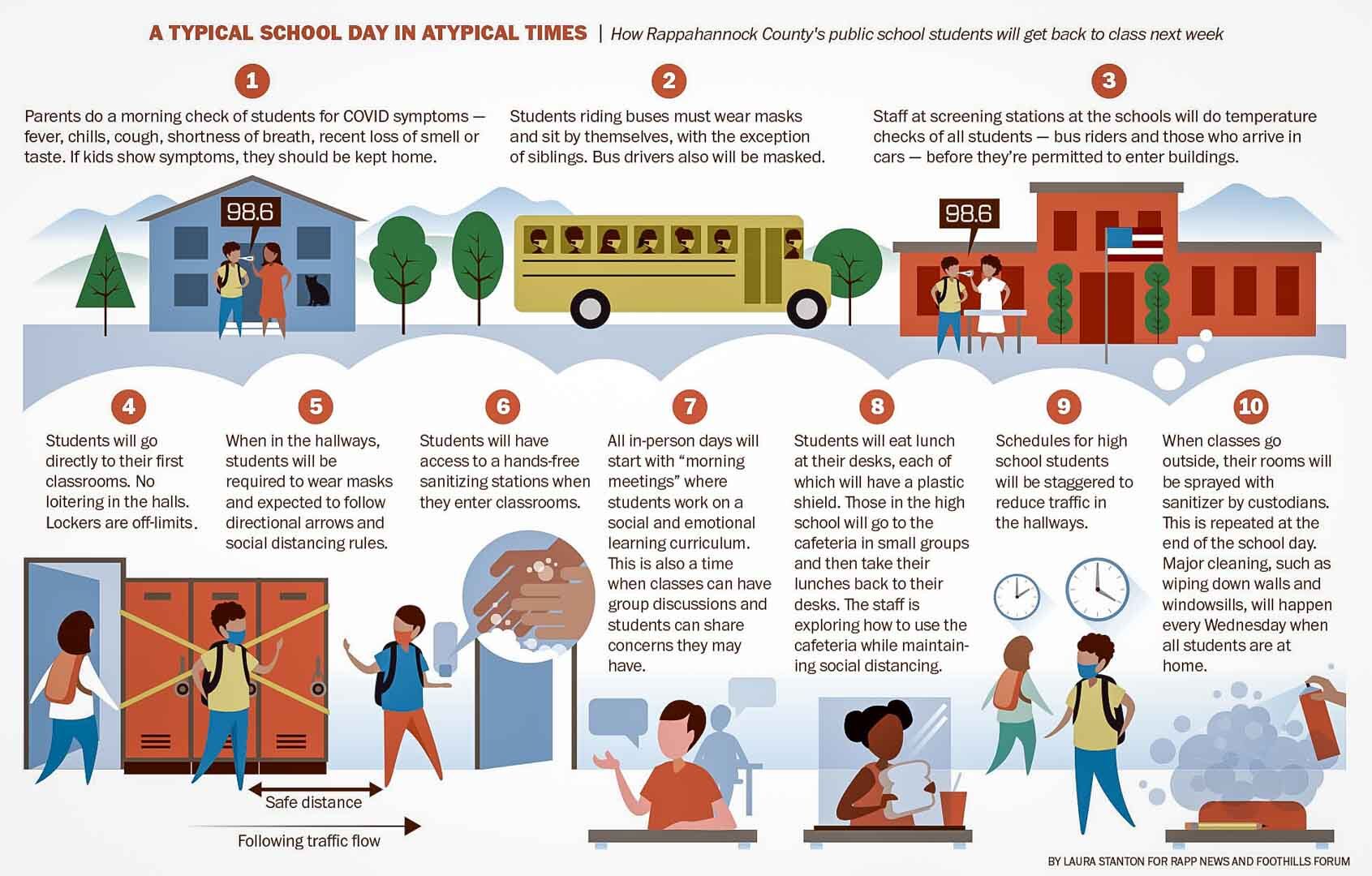‘A whole lot of moving parts’
When Rappahannock’s public school students return next Monday, they’ll kick off their school year with a temperature check.
They’ll be wearing masks, too, at least on the buses and in the hallways. They can remove them once they get to their desks, where they will be shielded with plastic barriers from their classmates.
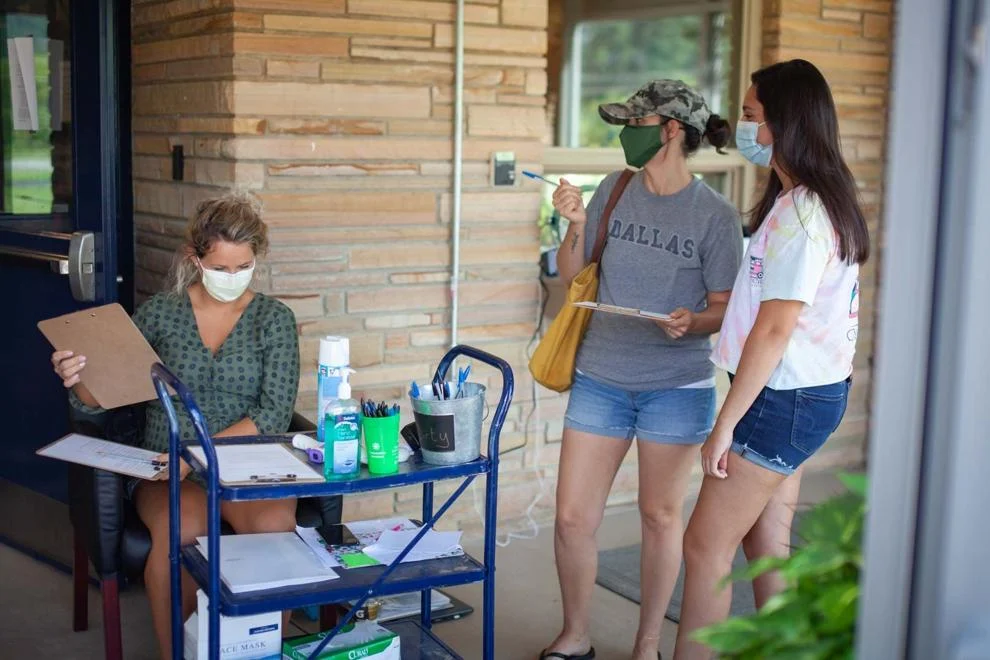
Lindsey Morris, athletic trainer, administers a wellness test for junior student Lana Hernandez and her mother, Natasha Eitzman. (Photo/Luke Christopher)
But beyond the obvious pandemic precautions, the school district is about to become part of something far more abstract and challenging. It is a kind of experiment to see not just how well students learn and teachers teach when a school’s top priority is to keep everyone safe, but also how kids, used to the messy swirl of personal connections and social interactions, adapt to an environment gone strangely antiseptic.
Earlier in the summer, Superintendent Shannon Grimsley had hoped that all students would be able to return on a close to normal schedule. But it soon became clear that if Rappahannock County Public Schools (RCPS) was going to meet Centers for Disease Control (CDC) guidelines on social distancing, it would need to cut the capacity of its two school buildings in half.
A total of 117 students will attend classes in person four days a week, although because of the space constraints, the district wasn’t able to accommodate many of the requests for that arrangement. Most of the parents who requested the maximum in-school option cited lack of child care, financial hardship or unreliable or no broadband access, according to Grimsley.
Most students (523) will be split into two groups and follow a hybrid schedule of two days of in-school classes and three days of virtual learning. A third set (133) has opted to stay at home and study only online five days a week.
“I am very worried about the lack of socialization,” said Kathy Sickler, the school district’s social worker. “I know safety has to come first. But seeing other kids only two days a week is not enough.”
“I feel for the kids,” added Jimmy Swindler, the high school’s principal. “Kids are wired to be social. What we need to do goes against that grain.”
Ideally, if the coronavirus data from state and regional health officials stabilizes, and the COVID-19 transmission rate in Rappahannock remains low, the RCPS will be able to switch to four days of in-person learning. But if the numbers worsen and Gov. Ralph Northam orders a move back to Phase 2, only students with special needs and young children will be permitted in the schools.
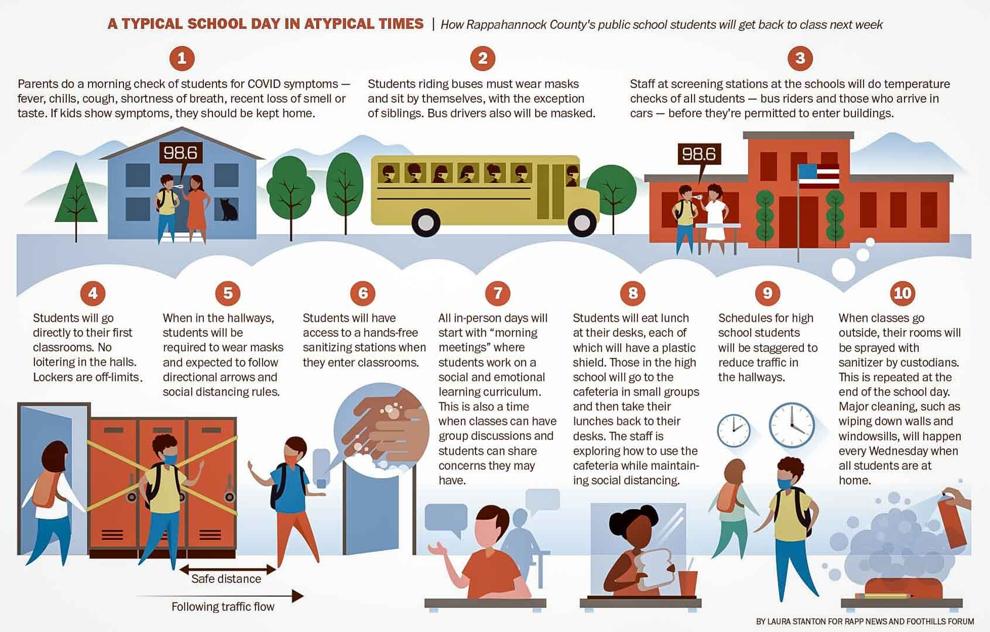
(Graphic/Laura Stanton)
Change is a constant
Any day things could change. That’s the reality. No matter how much planning and preparation has gone into making classroom learning possible, one outbreak could shut everything down again. If a student or staff member tests positive for the coronavirus, in-person learning could be cancelled for two to five days. That decision will be up to the school board.
As school nurse, Courtney Atkins is RCPS’s chief COVID-19 watchdog. If a student arrives with a temperature higher than 100 degrees, or other symptoms — such as a new cough, shortness of breath or loss of taste and smell — he or she will be sent to an isolation room where Atkins will do a more comprehensive assessment, including determining if the student has had any exposure to someone with the virus.
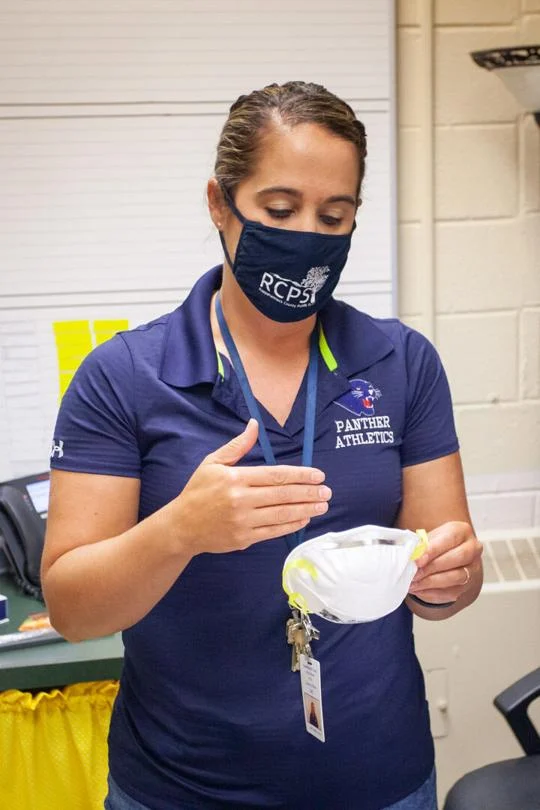
School Nurse and Athletic Director Courtney Atkins (Photo/Luke Christopher)
The student will be sent home, but if they haven’t been exposed, they can return to school 24 hours after their fever is gone.
“Children and staff should not be in school with a fever,” Atkins said. “But a fever can mean a lot of things, not just the coronavirus.”
If a student seems “highly suspicious” because they present COVID symptoms, they will be sent home, with a suggestion that they see a physician. If the doctor recommends a coronavirus test and it comes back negative, they will be able to return to school.
In the event a student or staff member tests positive, they’ll have to quarantine at home for 10 days after the diagnosis. If they report being exposed to someone with the virus, they’ll need to stay home and isolated from the sick person for two weeks.
If someone who has been in the school buildings tests positive, Atkins said she will work closely with the Virginia Department of Health on contact tracing and in determining what next steps should be taken, including temporary closure.
Another reality is that a positive case could spark calls to shut things down.
“Closing down over one positive case is not what our guidance would tell us to do,” Grimsley said. “But that might be what politics tells us to do, based on perception and the optics.”
Time for a reboot
When Gov. Northam ordered Virginia’s schools closed last March, the RCPS teachers and staff were thrown into the white water.
They had to scramble to convert curriculums designed for face-to-face teaching into disembodied lessons coming through a computer screen. In the process, they learned that they couldn’t rely on using videos or other streaming content because only about a third of Rappahannock students had suitable broadband connections in their homes.
They also saw that many kids struggled without the structure of a daily schedule and the familiarity of a classroom setting. Parents tried to pick up the slack, but often it was a thin patch.
Fifth grade teacher Layne Vickers pointed out that most elementary school children had little experience with online learning. Some took to it. “But,” she added, “a lot of parents said that getting their kids to sit down in front of the computer to do schoolwork was like pulling teeth.”
Still, teachers, parents and students managed to improvise a close to the school year. It was clear, though, that a reboot would be needed to reopen in August.

Special Education teacher Robert Glasker, former Technical Education teacher Roy Vickers and Layne Vickers chat in Layne’s classroom.
“It’s going to be a weird year, none of us have gone through this before,” said Roy Vickers, who taught at RCPS for 25 years and was picking up his wife Layne. (Photo/Luke Christopher)
But a reboot to what?
Even Superintendent Grimsley wasn’t quite sure. But she got a good sense of how complex and wide-ranging an undertaking it would be when the Virginia Department of Education released a 130-page planning guide, titled “Recover, Redesign, Restart” in June.
With a clearer picture of the state’s expectations, Grimsley and her team began developing a plan. But they didn’t have much time, and the guide covered a lot of ground.
They quickly created nine different task forces, inviting members of the community to join staff and teachers in tackling a broad set of issues — from health and safety to meals and transportation to reconfiguring spaces and schedules to addressing the social and emotional needs of students and staff.
“There were a whole lot of moving parts,” she said.
Clearing the air
Grimsley thinks that one benefit of having a separate committee focus on each of the tasks is that RCPS was able to get a jump on ordering the unusual batch of supplies needed to keep everyone in the schools safe. Some districts, she said, have had their requests placed on back order and may have to wait months.
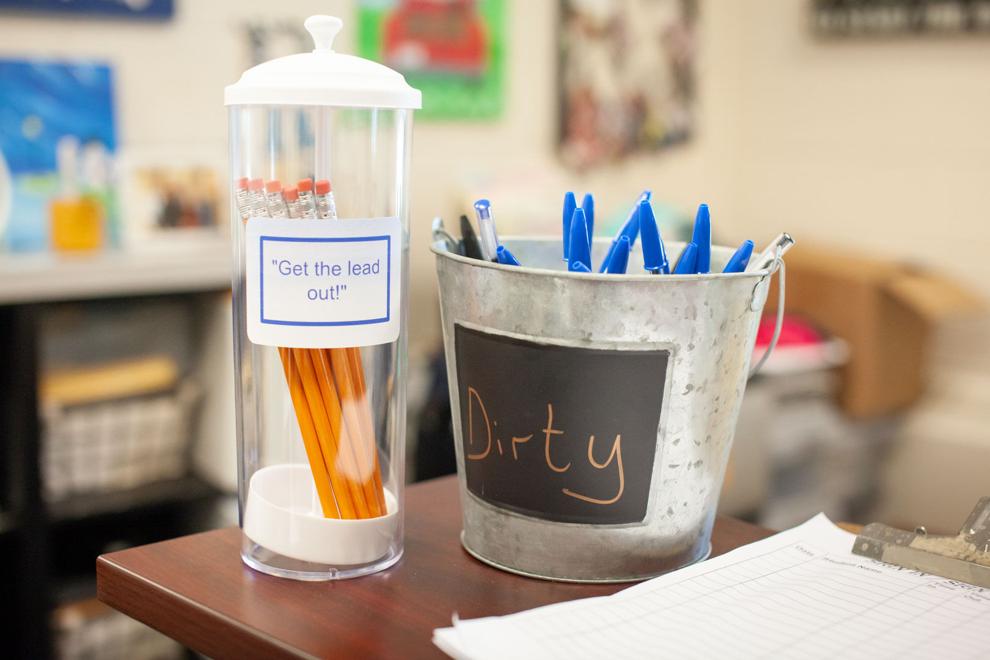
(Photo/Luke Christopher)
Much of the job of tracking down supplies fell to Robin Bolt, RCPS’s executive director of Administrative Services. She concedes that she faced a huge learning curve.
“There have been a massive amount of things that have never been on our radar before. The face shields, the N95 masks,” she said. “This is the hardest I’ve ever worked over the summer.”
In addition to purchasing 750 KN95 masks and 1,350 cloth masks to be made available to every student, teacher and staff member, Bolt ordered plastic shields to screen three sides of every student’s desk. She bought more than 100 touch-free hand sanitizer dispensers, which are now in every classroom, and spread around the schools and the RCPS administrative offices. And, she acquired five electrostatic backpack misters. They’ll be used to disinfect classrooms and hallways after school, and when students in a class are outside.
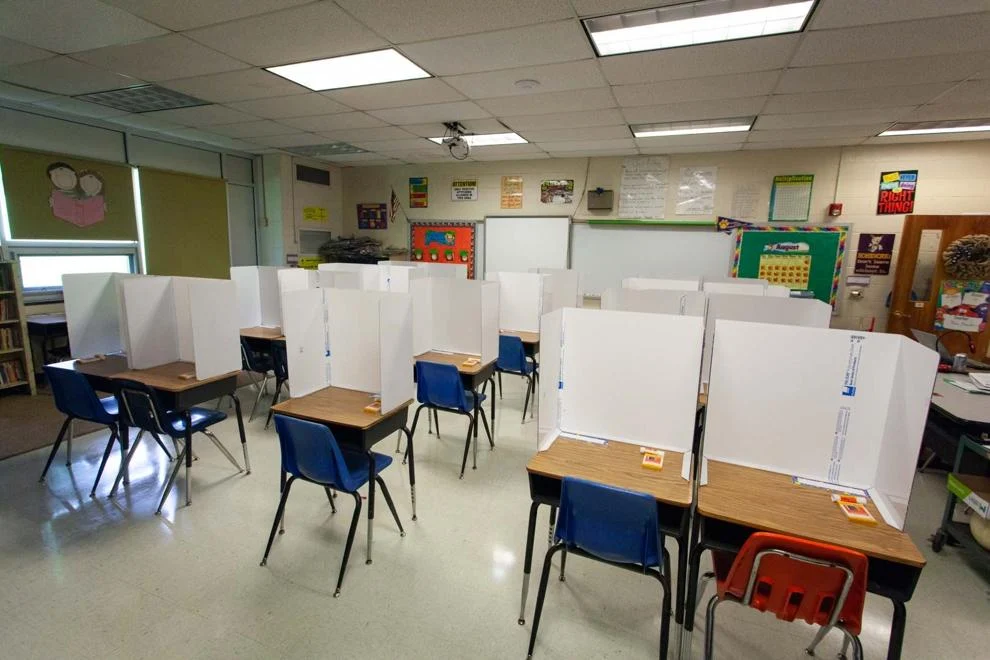
Protective barriers in a classroombefore the white shipping film was removed. (Photo/Luke Christopher)

Elementary teachers Elaine McCabe and Julie Ruth measure desks with clear plexiglass barriers installed atop. (Photo/Luke Christopher)
Playground equipment will also be sprayed daily. A “deep cleaning” where everything is wiped down, including walls and window sills, will be done every Wednesday, the day when all classes are virtual. The ventilation system will run two hours earlier in the morning and two hours later after school.
Grimsley estimated that since March, RCPS has incurred almost $450,000 in COVID-related expenses, including $62,000 to purchase devices for each student. She emphasized, though, that since it has been able to use funds from the Coronavirus Aid, Relief and Economic Security (CARES) Act and also repurpose other money in its budget, no additional county tax dollars have been spent.
Aside from when they’re seated at their desks, students will be required to keep their mouths and noses covered. Or as Grimsley put it: “If they’re on their feet, the mask is on.”
Principal Swindler said that students who choose not to wear a mask will be asked to switch to the all-virtual schedule. “We’re not going to turn this into a discipline issue,” he said. “Safety is not discipline. If you can’t do it, then you’re going to have to stay home and do all your learning remotely.”
Raising spirits
Swindler does feel that RCPS’s teachers have a better handle on online teaching than they did during the hectic days last spring. Many learned through trial and error, and the difficulties so many students had in streaming video only complicated matters. Now, students will be given flash drives which they can use to download content to home computers instead of depending on a good broadband connection.
Also, every student will be provided their own device — iPads for kids in Pre-K through first grade, Chromebooks for everyone else.

High School Principal Jimmy Swindler gives a wellness questionnaire at the portico entrance. (Photo/Luke Christopher)
Probably the most notable upgrade involves the use of an online platform called Virtual Virginia. First launched by the state’s Department of Education in 2006, it was ramped up dramatically last spring to enable teachers to use its virtual curriculum while being able to personalize the lessons.
In some ways, Swindler thinks a bigger challenge this year will be finding ways to provide the kind of shared experiences that shape friendships and memories. The cancellation of sports by the Virginia High School League until at least mid-December will make it that much harder.
“School sports in this country, more than anywhere else in the world, is such an integral piece of the fabric of our high school experience,” he said. “That’s the part I hope we can figure out.”
Swindler believes the high school should be able to sustain its peer mentor program, in which seniors and juniors are linked up with eighth graders to help them adapt to life in their new school. He likewise is hopeful that P.R.I.D.E. (Positive Relationships Inspire a Drive for Excellence), the extracurricular clubs started by teachers, can keep meeting in some form.
“We need to have ways kids can have fun, but still be safe,” he said.

(Photo/Luke Christopher)
For her part, Grimsley acknowledged that when students return next week, they could be feeling anxiety along with the usual start-of-school excitement. That’s to be expected, she said. The key is to keep a close track where they are emotionally and socially.
“You can’t really have any learning if their brains are occupied with anxiety and fear,” she said. “We want to get a pulse on that every day.”
The teachers came back to the schools earlier this month and have spent the past few weeks learning the new protocols and training to sharpen their virtual teaching skills.
They, too, likely worry about the uncertainty of the coming months.
“Yes, there are some anxieties, but I haven’t seen the angst and protesting other school districts are facing,” Grimsley said. “For the most part, our staff is ready to come back and be here for the children. There’s a sense that we need to be here.”
Kids and COVID-19
Here is some of the latest research on how the coronavirus affects children.
— While children comprise 22 percent of the U.S. population, about 7 percent of the coronavirus cases in the U.S. have been children up to the age of 17. (CDC)
— Analysis of COVID-19 data from 14 states found that the hospitalization rate among children with the virus (8 per 100,000) remains low compared to the rate for adults (164.5 per 100,000). But one in three hospitalized children was admitted to an intensive care unit, about the same rate as for adults. (CDC)
— There was a 90 percent increase in children’s coronavirus cases during a four-week period between July 9 and August 6. (American Academy of Pediatrics)
— Children have been .4 percent of COVID-19 deaths. Nineteen states have had no child deaths. (American Academy of Pediatrics)
— In a recent study, children under the age of 5 with COVID-19 were found to have more of the virus in their upper respiratory tract than adults or older children. (JAMA Pediatrics)
— A recent study in South Korea concluded that children younger than 10 were less likely to transmit COVID-19 than adults, but kids age 10 or older may transmit the infection at levels similar to adults. (Kaiser Family Foundation)


